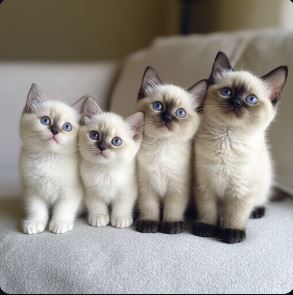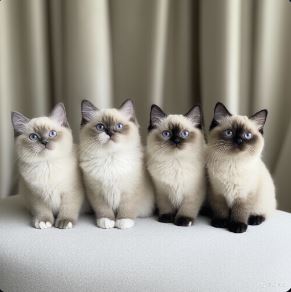Burmese Cats – Curious, Friendly and Highly Intelligent
Back in 2002, my daily routine involved feeding the birds in my backyard. It was something I truly enjoyed, watching the colorful lorikeets swoop down to feed. But even though I was surrounded by these beautiful creatures, I found myself yearning for a more personal connection—a pet that I could interact with on a daily basis.
I knew I wanted something intelligent, a pet that would engage with me in a way that went beyond the occasional look or movement. That’s when I started hearing more about Burmese cats.
I’d always been fascinated by cats, but it was the Burmese breed that really piqued my interest. People kept telling me how smart they were—highly intelligent, they said. I remember reading that Burmese cats loved to chirp and meow, almost like they were holding a conversation with you.
The idea of a cat that would “talk” to me throughout the day was incredibly appealing. It wasn’t just about having a pet for companionship; I wanted an animal that would actively engage with me, communicate in its own way, and be a part of my day-to-day life.
The Quest for a Burmese Cat
As I was considering bringing a Burmese cat into my life, I remembered something my boss had once told me. We’d been talking about pets, and she gave me this advice: “If you’re not going to be home with your pet very much, it’s selfish to get just one. You should get two so they can bond with each other and have someone to talk to when you’re not around.”
had once told me. We’d been talking about pets, and she gave me this advice: “If you’re not going to be home with your pet very much, it’s selfish to get just one. You should get two so they can bond with each other and have someone to talk to when you’re not around.”
That stuck with me. It made a lot of sense, and it got me thinking. Burmese cats are known to be highly social animals. They thrive on interaction, not just with humans, but with other cats as well.
Maybe I should get two, I thought. That way, when I wasn’t home, they’d still have each other for company.
But for some reason, despite this sound advice, I ended up focusing on getting just one. Perhaps it was the logistics of managing two cats, or maybe I just wanted to start small and see how I handled one before doubling the responsibility.
Ragdoll Cats – they love humans
The Maine Coon – they stay young for a long time
What Do I Need To Know About Cat Adoption?
My Cat Keeps Doing Weird Things
Turning to the Yellow Pages
Back in those days, I didn’t have the internet at my fingertips like we do now. So, when I finally made the decision to adopt a Burmese cat, I did what anyone would have done in 2002—I grabbed the Yellow Pages.
Yes, the good old thick book that had just about every business listed, from plumbers to cat breeders. Flipping through the pages, I found a local breeder who specialized in Burmese cats.
Excited, I called the breeder and told him I was looking for an 8-week-old kitten. From what I had read and heard, 8 weeks seemed to be the ideal age for adopting a kitten.
At that age, the kitten is still young enough to bond with its new owner easily and adapt to a new home. But to my surprise, the breeder told me, “We don’t have any 8-week-old cats. I’ve got a 20-week-old one!”
That threw me off. Twenty weeks seemed too old compared to the perfect 8-week-old kitten I had in mind. I hesitated because I had become convinced—perhaps too convinced—that 8 weeks was the magic number.
Every book, every video I had watched suggested that the younger the kitten, the easier it was to raise and bond with.
A Change of Heart
 Despite the breeder’s offer of a 20-week-old Burmese, I decided not to go ahead with it. It wasn’t that I didn’t want the cat—I just felt it wasn’t ideal.
Despite the breeder’s offer of a 20-week-old Burmese, I decided not to go ahead with it. It wasn’t that I didn’t want the cat—I just felt it wasn’t ideal.
I figured I’d wait for an 8-week-old kitten to become available, but in the end, I never did get a Burmese cat. Life happened, as it often does, and my plan to bring one into my home just slipped away.
Becoming a Cat Babysitter
Although I never ended up owning a Burmese cat myself, I did have plenty of opportunities to experience their unique personalities up close. My neighbors had not one, but two Burmese cats, and whenever they went away, I became the designated cat sitter.
At first, when I would enter their house, the two cats would completely ignore me. It was clear they were expecting their humans, and I was just the temporary stand-in.
They’d give me that classic cat indifference, probably wondering why I wasn’t their usual caregiver. But after a few minutes, their aloofness would melt away, and they’d begin to approach me, one by one.
Soon, one of them would come over, holding their favorite toy in its mouth, almost as if to say, “Can you please wave this around in front of my face so I can play with it?”
That’s when I started to truly understand what people meant when they talked about the Burmese being such interactive and communicative cats. They weren’t just content to sit around and observe; they wanted to be part of the action, to engage with me, and to play.
The Burmese Personality: A Joy to Be Around
I also noticed that Burmese cats have this unique way of being affectionate and playful at the same time. They’re gentle, yet curious, and they form strong bonds with people.
Once they warmed up to me, they would follow me around the house, and when I sat down, they’d curl up beside me, purring contently. It felt like they really enjoyed human company and weren’t afraid to show it.
What surprised me even more was that these two Burmese cats lived with two large German Shepherds in the same house. And the house wasn’t particularly big! Despite that, the cats seemed completely at ease, confident in their space, and they had no trouble coexisting with the dogs.
The whole household, in fact, seemed harmonious, with the Burmese cats and the dogs sharing space without any issues. It was a testament to the adaptable and social nature of Burmese cats—they really do get along with just about anyone.
Looking back, I sometimes wonder what it would have been like if I had gone through with adopting that 20-week-old Burmese cat. Would I have ended up getting two?
Would I have had the same joyful experiences that I did while babysitting my neighbors’ cats? I may never know, but what I do know is that Burmese cats are a truly special breed.
They are intelligent, social, and incredibly interactive. Their love for communication, whether it’s through their chirps, meows, or body language, makes them stand out among other breeds.
And while I didn’t end up with one myself, I’ve seen firsthand how they bring joy, companionship, and a sense of fun to the people around them. They really are a joy to be around—whether you have one or two!
What did/do these celebrities think of Burmese cats?
Marlon Brando and Burmese Cats
Taylor Swift and her Burmese Cat/s
Audrey Hepburn and her Burmese Cat
William Shatner and his Burmese Cat
Some Common Burmese Cat Questions
Burmese Cat Personality Traits
Burmese Cat History and Origin
Burmese Cat Compatibility With Other Pets